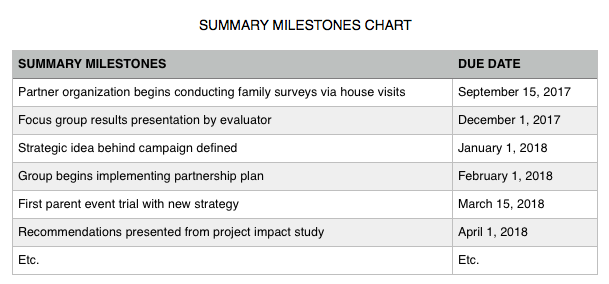Break down your mission statement into the main objectives of your project. Your objectives should be specific, measurable, and results-focused. By attaching dates by which these objectives will be met you will establish milestones that will help to hold the team accountable and keep your project on track.
The first milestones date back to the Roman Empire. They were stones with information carved on them to help keep travelers on the right path. For our purposes, milestones describe either the start or result of important phases of our project. They create focus points on an otherwise blurry map.
Now we get to break down that abstract, non-specific, head-in-the-clouds mission statement into achievable, measurable chunks. SMART goal enthusiasts will be breathing a sigh of relief. Keep in mind that because we have yet to create a detailed list of our stakeholders or bothered to ask their opinion on the project it is too early to get very specific on the scope or magnitude of the project. These milestones are still pretty high level. But they do enable us to come up with a timeline that keeps us from sounding like fools when we are delivering our elevator speech describing our project to our colleagues. This is an iterative process. Milestones can and probably will change a bit as we seek advice from the people who will be affected by the project itself, but for now we can get a solid start.
Let's break down a mission statement from our previous post into milestones. This project is set to start August 2017.
Mission Statement: Over the course of three years we will determine the obstacles that families in our community face in supporting their children academically and will partner with them to overcome those obstacles. Through conducting targeted market research we will discover what motivates our community to enter our school building and will use that knowledge to design events they won't be able to resist and deliver advertising strategies that continue to draw them in.

A milestone is not the result of one effort, but many. From here you can start to see the map come into focus. The details of that map will come after we create our scope statement and begin creating our work breakdown structure (WBS). The creation of high-level or summary milestones helps us to begin telling the story of how we plan to achieve our mission. Keep in mind that the story is subject to change. Don't get too attached just yet! Look out next week for Step 5: List Assumptions and Constraints.
Have you made traction on listing your milestones? Let Tom know about it!
To read the previous posts in this series, please click on the links below:
Introductory Post: 25 Steps to Small Project Success
Project Step #1: Create a Problem Statement
Project Step #2: Create a Vision Statement
Project Step #3: Create a Mission Statement



Comments [0]
Click here to read/write comments